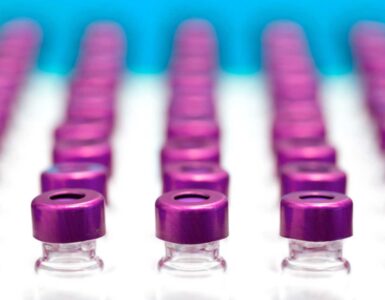Despite a failed Phase 2 trial in pulmonary arterial hypertension (PAH), Eiger BioPharmaceuticals (NASDAQ:EIGR) still has multiple shots on goal with its targeted therapies for orphan diseases, including a number of key milestones in 2018.
“While we are disappointed in the LIBERTY study outcome, we have always recognized that PAH is a complex disease and that this was a translational program, moving from animal data into human testing in the clinic,” president and CEO, David Cory, says in an interview with BioTuesdays.
“Our pipeline was built specifically for this purpose, to reduce risk against a single binary event in order to avoid a situation where if one program fails, we would not implode and close our doors,” he adds. “We have multiple shots on goal.”
Mr. Cory said Eiger has already generated Phase 2 clinical proof of concept data in its two lead programs in hepatitis delta virus (HDV) and post-bariatric hypoglycemia (PBH).
Among Eiger’s milestones this year is an end-of-Phase 2 meeting in February with the FDA to discuss Phase 3 registration plans for its HDV program. In the third quarter, the company expects to announce additional Phase 2 data in PBH and Phase 2 data in lymphedema.
HDV is the most severe form of human viral hepatitis and is always associated with hepatitis B virus (HBV) infection. Hepatitis delta is more aggressive, leading to more severe liver disease than HBV alone and is associated with accelerated liver fibrosis, liver cancer, and liver failure. At diagnosis, 50% of HDV patients already have cirrhosis.
There are an estimated 110,000 HDV patients in the U.S., nearly twice as many in Western Europe, and no approved therapy anywhere in the world.
Eiger has two complementary assets for HDV: lonafarnib, an oral drug candidate, which has completed Phase 2 testing, and pegylated interferon lambda (Lambda), which will complete Phase 2 testing in HDV in August.
“With lonafarnib and Lambda, we have the potential for multiple treatment options for physicians and patients,” says Ingrid Choong, senior director of clinical affairs and corporate development.
The company has dosed more than 120 HDV patients across five Phase 2 studies at multiple international sites with lonafarnib, which has orphan drug designation in the U.S. and Europe. Recommended doses and regimens for registration have been identified.
Specifically, all-oral lonafarnib in combination with ritonavir as well as a combination of lonafarnib, ritonavir and interferon demonstrated that more than 50% of patients achieved a greater or equal to 2-log decline or undetectable HDV RNA after 24 weeks of treatment. In addition, the majority of these patients had normalized alanine aminotransferase (ALT), a blood test that checks for liver damage.
Eiger is also developing Lambda as a better-tolerated interferon for the treatment of HDV, alone and/or in combination with lonafarnib. Lambda was in-licensed from Bristol-Myers Squibb, where it was previously in development as a better-tolerated interferon for hepatitis C and B viruses, with more than 3,000 patients dosed in 17 clinical trials, producing a well-understood safety database.
Dr. Choong explains that Lambda and interferon-alfa use the same signaling pathway and the same mechanism of action. However, Lambda is a Type III interferon, which binds to a unique Lambda receptor, compared with Type I alfa.
“Receptors for Lambda are much more focused in the liver, compared with interferon-alfa receptors, and, as a result, have the potential for fewer side effects.” Those include less flu-like symptoms, psychiatric disorders and episodes of neutropenia, which reduces the body’s ability to fight off bacterial infections.
Eiger has an on going Phase 2 LIMT study of Lambda monotherapy in HDV. Enrollment is complete with 33 HDV patients between sites in New Zealand, Pakistan and Israel. The company expects to complete the LIMT study in the third quarter of 2018.
Interim data from the LIMT HDV study was presented at the American Association for the Study of Liver Diseases in 2017 and demonstrated that of the 10-of-33 patients who had reached week 24 at the time of analysis, five patients were considered responders, achieving greater than a 2-log decline in HDV RNA, or undetectable HDV RNA, at week 24.
Dr. Choong says the interim data suggests that Lambda is comparable to interferon-alfa in antiviral activity against HDV. In addition, investigators in the LIMT HDV study indicated that approximately 40% of their patients were previously treated with interferon-alfa, and they noted that Lambda was much better tolerated.
“Observations of ALT flares is associated with HDV viral load declines [suggestive of] a vigorous immune response to therapy rather than hepatotoxicity or drug-induced liver damage,” she adds. “We believe Lambda is a promising investigational agent, alone or in combination therapy for HDV.”
At its end-of-Phase 2 meeting with the FDA in February, Eiger will propose a Phase 3 study with two treatment arms: an all-oral therapy of lonafarnib in combination with ritonavir as well as a combination arm of lonafarnib, ritonavir, and Lambda.
The proposed primary endpoint for registration in HDV will likely be similar to those used previously by regulatory agencies for approval of drugs currently marketed to treat HBV infection, including a reduction in viral load and normalization of liver enzymes. The secondary endpoint would be improvement in the histological activity as measured by liver biopsy.
Mr. Cory says the end-of-Phase 2 meeting with the FDA could be a transformative event, making Eiger a late-stage company, developing the first regimen for HDV.
In its post-bariatric hypoglycemia (PBH) program, Eiger has completed three clinical studies with exendin 9-39, dosing 36 patients, with statistically significant proof-of-concept data presented at medical conferences and published in peer-reviewed journals.
PBH is a serious complication after bariatric surgery, which can achieve dramatic weight loss and resolution of Type 2 diabetes. However, certain hormones that regulate glucose metabolism often do not rebound after surgery. After every meal, these patients have a spike in insulin production and very quickly have their glucose degrade, become hypoglycemic and often fall into a coma and require immediate treatment in hospital emergency rooms.
“PBH patients often cannot work, cannot drive, cannot be alone, and need a caregiver,” Mr. Cory says. “This is a dismal result to what should be a very positive surgical procedure.”
In 2015, there were some 300,000 bariatric surgeries performed in the U.S. and Europe. The estimated prevalence of PBH is 70,000 in the U.S. and Europe and growing because of the popularity of bariatric surgery. There is no approved therapy for PBH.
Eiger is developing exendin 9-39, a GLP-1 antagonist, for PBH. GLP-1 is a hormone that is secreted by the lower small intestine that stimulates insulin secretion. PBH patients produce excessive levels of GLP-1, which causes a spike in insulin production, followed by hypoglycemia, after every meal.
“We know that physically blocking the GLP-1 receptor blunts this problem, attacking the root of PBH,” Mr. Cory contends, adding that exendin 9-39 is designed to normalize insulin secretion and decrease symptoms of PBH, and “our Phase 2 program supports this hypothesis.”
In the fourth quarter of 2017, Eiger initiated a 28-day Phase 2 study, known as PREVENT, with the objective of demonstrating durability of effect of exendin 9-39. Data from the study are expected in the third quarter of 2018, setting the stage for another possible end-of-Phase 2 meeting with the FDA.
“This is another transformative program that could take us from Phase 2 into Phase 3 within the next 12 months,” Mr. Cory suggests.
In addition to HDV and PBH, Eiger is developing ubenimex for lymphedema, a state of vascular insufficiency, where the lymphatic system is blocked and proteinaceous fluid accumulates in the arm or leg, causing tissue remodeling. The disorder most often results after surgery or radiation, where lymph nodes are damaged or removed.
Last year, the peer-reviewed journal, Science Translational Medicine, published Eiger’s extensive preclinical studies of ubenimex, demonstrating that modulation of the inflammatory mediator, leukotriene B4 (LTB4), improved experimental lymphedema. In addition, targeted reduction of LTB4 with ubenimex reversed edema, improved lymphatic function and restored lymphatic architecture in experimental models of lymphedema.
Ubenimex has been marketed in Japan for over 30 years as an adjuvant to chemotherapy for a certain forms of leukemia, but has never been introduced in the U.S. or Europe. “This is a well-characterized and well-tolerated drug in its approved indication, with an established safety profile,” Mr. Cory points out.
Eiger has completed enrollment for the Phase 2 ULTRA trial of 54 patients with primary and secondary lymphedema in the lower limbs. Mr. Cory says the study has multiple primary and secondary endpoints, with an objective to show proof of concept that the LTB4 pathway, when modulated, can improve clinical lymphedema. Data readout for ULTRA is scheduled for third quarter of 2018.
“Our focus is developing well-characterized drugs acting on newly identified or novel, validated targets,” Mr. Cory says. “By systematically reducing the time and cost of drug development, Eiger hopes to more rapidly deliver medicines to patients with orphan diseases.”
• • • • •
To connect with Eiger, or any of the other companies featured on BioTuesdays, send us an email at [email protected].







